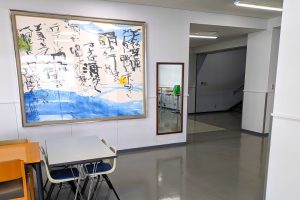ブログ
“どんなに強くもとめても手にすることができないもの”
4月になり1か月が経ちました。中学校1年生、高校1年生も、少し緊張している様子もまだありますが、朝の挨拶では声が出るようになってきています。
4月16日から18日中学校1年生のオリエンテーション合宿に付き添いました。3日とも天気に恵まれ、予定通りの活動ができました。1日目は、バスで宿舎につくと開校式、昼食後、樟蔭レッスンを行いました。樟蔭レッスンでは、樟蔭学園の歴史や建学の精神について学び、また、挨拶の言葉の意味や挨拶をする効果などを学びました。生徒たちは非常に熱心に聞き、質問には手を挙げて答えていました。その後は、晩御飯のカレーライスを作るための飯盒炊爨に向かいました。初めて体験する生徒もおり戸惑う場面もありましたが、クラスメートと協力して作ったカレーをおいしいと言って食べていました。
2日目は午前中チームビルディングとして、グループに分かれて、インストラクターの指導の下、様々なゲームを行い、仲間と協力する大切さと楽しさを学んでいました。午後は筏レースで、生徒たち自身が作った筏に乗り琵琶湖に漕ぎ出しました。向かい風でもあり、力を合わせないと筏はうまく進みませんが、こちらも声を出して協力する中、たくさんの新たな絆が生まれたようでした。夜は、日ごろお世話になっている保護者の方々などに感謝を伝えるためハガキを書きました。初めてという生徒も多く、郵便番号や住所の書き方から教えてもらい、裏面の自分の感謝をどう伝えるか、いろいろと悩んでいましたが、最後には気に入ったものができたようでした。
3日目は琵琶湖博物館に行き、琵琶湖についての講演を聞き、館内の見学をしました。3日間という短い期間ではありましたが、生徒たちは大きく成長してくれたと思います。
ところで、本校を訪問していただいた方で、高校のHR教室がある校舎、千種館の2階ホールに、墨で書かれた詩が壁一面の大きな額に入れられ飾ってあるのをご覧になった方もおられると思います。三年前本校に赴任して以来気になっていたのですが、「どんなに深く憧れ、どんなに強く求めても」あたりまでは何とか読めるのですが、あまりに達筆で、そのあとは部分的にしかわかりませんでした。先日、詩の最後に「谷川俊太郎」とあるのを見つけ、調べてみると「青は遠い色」という谷川俊太郎氏の詩であることが分かりました。

「青は遠い色」
「どんなに深く憧れ、どんなに強く求めても、青を手にすることはできない。
すくえば海は淡く濁った塩水に変わり、近づけば空はどこまでも透き通る。
人魂もまた青く燃え上がるのではなかったか。
青は遠い色。」
海の色、空の色、また植物などにも様々な青を見つけることができます。青色を好きな人もおられると思います。有名な画家にも青にこだわりを持った方がおられるそうです。“青春”、最近は“アオハル”という言い方も多いそうですが、中学生高校生時代の「初々しさ」「夢や希望」「思春期」「若さ」「未熟さ」など、多くの思いが交錯する人生の一時期にも“青”が使われています。この額を書かれた方も、中高生の時期を表す詩として生徒たちに味わってほしいと思われたのではないでしょうか。機会を見つけて生徒たちにも紹介したいと思います。
樟蔭中学校高等学校 校長 小嶋信男
“No matter how strongly we yearn, we can never obtain it.”
It is already April. Students in the first grade of junior high and high school still appear to be a little nervous, but they are able to cheerfully greet each other in the morning. From April 16th to 18th, I joined the first grade of junior high school in their 3-day orientation trip. We were blessed with good weather and thankfully everything went according to plan.
On the first day, we arrived at the accommodation by bus, had the opening ceremony, then after lunch we had a lesson about Shoin. We learned about the history of Shoin along with the words we use to greet each other and the effect of greeting people. The students listened to the lesson very enthusiastically and raised their hands to answer many questions. Afterwards, students faced the rice cooker and proceeded to make curry and rice for their evening meal. At first, they found the task a little difficult, but by working together, they managed to make a dish that was praised by everyone.
On the second day, as a team building activity, students were divided into groups and under the directions of the instructor, played various games in which they learned the joys of teamwork and co-operation. In the afternoon, students had a raft race on lake Biwa in rafts they had made by themselves. There was a headwind and without working together as a team, the rafts would not advance forward. The students succeeded in forming good bonds with each other through this exercise. In the evening, students wrote a postcard to their parents expressing their appreciation for the care they receive every day. It was the first time for some students to write their address and use a post office, but they managed to overcome the difficulties and send a postcard they could feel happy about.
On the third day, we went to the Lake Biwa Museum and learned about the history of the lake. It was a very short trip but I feel the students developed a lot over the three days.
In other news, I’m sure visitors to the school have seen the poem written in ink in a frame on the wall on the second floor of the “Chigusa-kan” building. I’ve been curious about it since I came to this school three years ago, and since the writing is so artistic, I had trouble reading past the part, “how deeply we admire…how strongly we yearn…” At the end of the poem is the writer’s name, Tanikawa Shuntarou, and recently after researching I found the poem was called “Blue is a distant color.”
Blue is a distant color.
“No matter how deeply we admire, no matter how strongly we yearn, we can never obtain blue.
If we scoop up the sea, it is just murky saltwater.
If we approach the sky, it is endlessly transparent.
The human soul doesn’t burn blue.
Blue is a distant color.”
We can find blue in the sea, the sky, and in many plants and flowers. Also, there are many people who like the color blue. Many famous artists have also been fixated with blue. Recently, the word “blue spring” is also quite common. In the junior high and high school generation, the words “innocence,” “dreams and hopes,” “adolescence,” “youth,” “immaturity,” conjure up mixed emotions about a certain time in our lives and all use the Chinese character for “blue.” I’m sure the poet also wanted young students to appreciate their youth through this poem. If I have the opportunity, I’d like to introduce the poem to Shoin students, too.
Shoin Junior and Senior High School Principal – Nobuo Kojima

